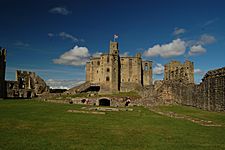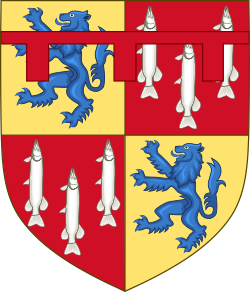Henry Percy (Hotspur) facts for kids
Quick facts for kids {{{name}}} |
|
|---|---|
 |
|
| The pennon of Percy captured by James Douglas, Earl of Douglas | |
| Spouse(s) | Lady Elizabeth Mortimer |
| Issue | |
| Noble family | House of Percy |
| Father | Henry Percy, 1st Earl of Northumberland |
| Mother | Margaret Neville |
| Born | 20 May 1364 Warkworth, Northumberland, England |
| Died | 21 July 1403 (aged 39) Shrewsbury, Shropshire, England |

Sir Henry Percy (born May 20, 1364 – died July 21, 1403) was a famous English knight. He was often called Hotspur or Harry Hotspur. This nickname came from the Scots, who admired his speed and eagerness to fight.
Hotspur fought in many battles. He helped defend England's northern border against the Scots. He also fought against the French during the Hundred Years' War. Henry Percy came from a powerful family in northern England. He played a key role in removing King Richard II from power in 1399. He then helped Henry Bolingbroke become the new king. However, Hotspur later disagreed with King Henry IV. He rebelled against the king and was killed in the Battle of Shrewsbury in 1403.
Contents
Early Life and Military Service
Henry Percy was born on May 20, 1364. He was likely born at Alnwick Castle or Warkworth Castle in Northumberland. His father was Henry Percy, 1st Earl of Northumberland. His mother was Margaret Neville.
When he was just 13, King Edward III made him a knight in 1377. He was knighted alongside future kings Richard II and Henry IV. In 1380, he served in Ireland. In 1383, he traveled to Prussia.
Hotspur became the Warden of the East March in 1384 or 1385. This meant he was in charge of defending the border with Scotland. In 1385, he joined King Richard II on a trip into Scotland. The Scots gave him the nickname 'Haatspore' (Hotspur). They admired his quick attacks on the border.
In 1386, he went to France to help protect the city of Calais. He also led raids into Picardy. He commanded a naval force in 1387. This force tried to help the city of Brest. For his bravery, he became a Knight of the Garter in 1388. He was only 24 years old.
Later in 1388, he led English forces against the Scots. This was at the Battle of Otterburn. He was captured during this battle but was soon set free after a ransom was paid.
Growing Reputation and Royal Favor
Hotspur's reputation continued to grow in the years that followed. Even though he was not yet 30, he went on a diplomatic mission to Cyprus in 1393. He was also appointed Lieutenant of the Duchy of Aquitaine from 1394 to 1398. This was a major role in a French territory.
He returned to England in 1395. He joined King Richard II's trip to Ireland. He was back in Aquitaine later that year. In 1396, he was again in Calais.
Hotspur's military and diplomatic work earned him many rewards from the king. He received lands and important positions. Despite these favors, the Percy family decided to support Henry Bolingbroke. Henry was rebelling against King Richard II. When Henry returned from exile in 1399, Hotspur and his father joined him. They marched south together. After King Richard was removed from power, the Percys were greatly rewarded. They received new lands and important jobs.
Challenges and Rebellion
Under the new King Henry IV, Hotspur had many important duties. He was responsible for both civil and military matters. He worked in the East March near Wales. He was also in charge of the north toward Scotland.
In north Wales, a rebellion led by Owain Glyndŵr was causing problems. In 1402, King Henry IV made Hotspur his royal lieutenant in north Wales. On September 14, 1402, Hotspur, his father, and the Earl of Dunbar and March defeated a Scottish force. This was at the Battle of Homildon Hill. They captured many Scottish leaders, including Archibald Douglas, 4th Earl of Douglas.
Despite the king's favors, the Percy family became unhappy. They had several reasons for their discontent:
- The king did not pay them for defending the Scottish border.
- The king showed more favor to Dunbar.
- The king demanded that the Percys hand over their Scottish prisoners.
- The king did not end Owain Glyndŵr's rebellion through talks.
- The king gave more military power to his son, Prince Henry, in Wales.
- The king did not help ransom Hotspur's brother-in-law, Sir Edmund Mortimer. Mortimer had been captured by the Welsh in 1402.
Because of these problems, the Percys rebelled in the summer of 1403. They took up arms against the king. Hotspur worked with Owain Glyndŵr. After his victory at Homildon Hill, Henry Percy made statements in Cheshire. He accused the king of being a "tyrant."
Hotspur marched to Shrewsbury with his uncle, Thomas Percy, Earl of Worcester. He planned to fight the Prince of Wales's army there. However, his father's army was slow to arrive. So, Henry Percy and Worcester reached Shrewsbury without his father's help. On July 21, 1403, they met the king's large army.
The Battle of Shrewsbury was very fierce. Many soldiers were killed on both sides. When Henry Percy himself was struck down and killed, his forces fled.
Death and Burial
The exact way Hotspur died is told differently in various stories. One writer said that Hotspur "rashly penetrating the enemy host, [Hotspur] was unexpectedly cut down." Another story says an arrow hit him in the face when he lifted his helmet to see better. This is the story told at Alnwick Castle, where a statue of him stands. The idea that Prince Hal (the future King Henry V) killed him was made popular by William Shakespeare. Shakespeare wrote about this much later. Hotspur's uncle, the Earl of Worcester, was executed two days after the battle.

King Henry IV reportedly cried when Hotspur's body was brought to him. Hotspur's body was taken to Whitchurch, Shropshire, for burial. But rumors spread that Hotspur was still alive. So, the king had his body dug up. It was displayed in the market square of Shrewsbury to prove he was dead. After this, Hotspur's head was sent to York. It was placed on the Micklegate Bar, one of the city's gates. His body was divided and displayed in London, Newcastle upon Tyne, Bristol, and Chester. Finally, his body parts were given to his widow. She had him buried in York Minster in November 1403. In January 1404, Hotspur was officially declared a traitor. His titles and lands were taken by the Crown.
Family Life
Henry Percy married Elizabeth Mortimer. She was the eldest daughter of Edmund Mortimer, 3rd Earl of March. Elizabeth's mother was Philippa. Philippa was the only child of Lionel, 1st Duke of Clarence.
Henry and Elizabeth had two children:
| Name | Lifespan | Notes |
|---|---|---|
| Henry | February 3, 1393 – May 22, 1455 | He became the 2nd Earl of Northumberland. He married Eleanor Neville and had children. He was killed in the First Battle of St Albans during the Wars of the Roses. |
| Elizabeth | c.1395 – October 26, 1436 | She first married John Clifford, 7th Baron de Clifford. They had children. He was killed in 1422. She then married Ralph Neville, 2nd Earl of Westmorland. They had a son named Sir John Neville. |
After 1406, Elizabeth Mortimer married Thomas de Camoys, 1st Baron Camoys. They had a son named Sir Roger Camoys. Thomas Camoys was a brave soldier. He commanded part of the English army at the Battle of Agincourt in 1415.
Hotspur's Legacy

Henry Percy, 'Hotspur', is a very famous character in Shakespeare's play Henry IV, Part 1. In the play, Hotspur is shown as being the same age as his rival, Prince Hal. Prince Hal is shown killing Hotspur in a fight. However, in real life, Hotspur was 23 years older than Prince Hal. Prince Hal, who became King Henry V, was only 16 when the Battle of Shrewsbury happened.
One of England's football clubs, Tottenham Hotspur F.C., is named after Hotspur. He lived in the area, and his family owned land near where the club's first stadium was built.
A 14-foot (4.3 m) statue of Henry Percy was unveiled in Alnwick in 2010. The Duke of Northumberland revealed it.
Tom Glynn-Carney played Hotspur in the 2019 movie The King.
Images for kids
-
Statue of Harry Hotspur in Alnwick, Northumberland, unveiled in 2010
-
Shortly after Henry died in battle, his uncle was executed. The family's property, including Wressle Castle in Yorkshire, was taken by the Crown.
-
Warkworth Castle, one of Henry Percy's homes







